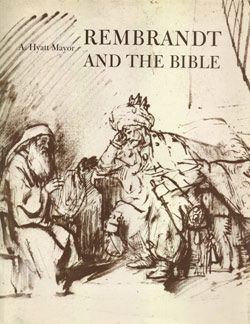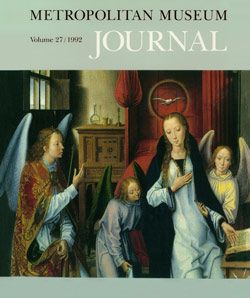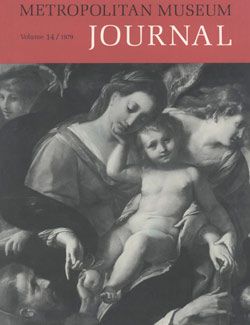MetPublications
Showing 1–10 results of 41
Sort by:
 Part of a collection formed over the past five decades by Mr. and Mrs. Charles Wrightsman, the 124 paintings, drawings, and pastels in this catalogue range in date from the early sixteenth to the late nineteenth century; some remain in Mrs. Wrightsman's personal collection, while others have been given to or purchased for the Metropolitan Museum of Art. Among the most notable of these works are masterpieces by Lorenzo Lotto, Guercino, El Greco, Rubens, Georges de la Tour, Van Dyck, Vermeer, Jacques-Louis David, and Caspar David Friedrich, as well as numerous paintings by the eighteenth-century Venetian artists Canaletto, Guardi, and the Tiepolos, father and son, plus a dozen remarkable portrait drawings by Ingres, the largest holding of the artist's drawings currently in private hands. Well-known artists are joined by those who are brought to fresh awareness through the commentary that accompanies each work. About half of the pictures in the catalogue were acquired after the Wrightsman collection was first published in 1973. As a testament to the continuing passion and discernment of Mrs. Wrightsman, this volume celebrates the generosity of a great benefactor.Download PDFFree to download
Part of a collection formed over the past five decades by Mr. and Mrs. Charles Wrightsman, the 124 paintings, drawings, and pastels in this catalogue range in date from the early sixteenth to the late nineteenth century; some remain in Mrs. Wrightsman's personal collection, while others have been given to or purchased for the Metropolitan Museum of Art. Among the most notable of these works are masterpieces by Lorenzo Lotto, Guercino, El Greco, Rubens, Georges de la Tour, Van Dyck, Vermeer, Jacques-Louis David, and Caspar David Friedrich, as well as numerous paintings by the eighteenth-century Venetian artists Canaletto, Guardi, and the Tiepolos, father and son, plus a dozen remarkable portrait drawings by Ingres, the largest holding of the artist's drawings currently in private hands. Well-known artists are joined by those who are brought to fresh awareness through the commentary that accompanies each work. About half of the pictures in the catalogue were acquired after the Wrightsman collection was first published in 1973. As a testament to the continuing passion and discernment of Mrs. Wrightsman, this volume celebrates the generosity of a great benefactor.Download PDFFree to download Considered to be without peer among American private collections of old masters, the Wrightsman Collection of paintings, drawings, and sculpture is here catalogued by two of the most distinguished authorities in the field and fully illustrated in black-and-white and color. Volume V completes the series, Volumes I and II having been devoted to furniture and gilt bronze; Volumes III and IV to snuffboxes, silver, porcelain, and other objects of decorative art. An introduction by John Walker, Director Emeritus of the National Gallery of Art in Washington, D.C., gives a fascinating history of the way in which the Wrightsman Collection has been built up and refined; Sir John Pope-Hennessy, Director of the Victoria and Albert Museum, provides an authoritative introduction to the sculpture section. Each entry includes a large-size illustration of the object (all the paintings are in full color) as well as many detailed views and comparable examples; the text is made up of a biography of the artist, physical description, provenance, and scholarly discussion, as well as a listing of other versions, exhibitions, references, and technical notes.Download PDFFree to download
Considered to be without peer among American private collections of old masters, the Wrightsman Collection of paintings, drawings, and sculpture is here catalogued by two of the most distinguished authorities in the field and fully illustrated in black-and-white and color. Volume V completes the series, Volumes I and II having been devoted to furniture and gilt bronze; Volumes III and IV to snuffboxes, silver, porcelain, and other objects of decorative art. An introduction by John Walker, Director Emeritus of the National Gallery of Art in Washington, D.C., gives a fascinating history of the way in which the Wrightsman Collection has been built up and refined; Sir John Pope-Hennessy, Director of the Victoria and Albert Museum, provides an authoritative introduction to the sculpture section. Each entry includes a large-size illustration of the object (all the paintings are in full color) as well as many detailed views and comparable examples; the text is made up of a biography of the artist, physical description, provenance, and scholarly discussion, as well as a listing of other versions, exhibitions, references, and technical notes.Download PDFFree to download There has always been an important affinity between great museums and distinguished connoisseurs of art. It is a relationship of mutual enrichment but one of special importance to the museums, since traditionally they gain their finest treasures from enlightened and generous collectors. So it has been in the association of The Metropolitan Museum of Art with Jayne and Charles Wrightsman, who, in a relatively short period of time—beginning in 1952—amassed the finest private collection in America of the decorative arts of the ancien régime. Mr. Wrightsman was first elected to the Board of Trustees of the Metropolitan in 1956; upon his retirement in 1975 he was made Trustee Emeritus and Mrs. Wrightsman was elected to the Board. Throughout these years the Wrightsmans' active interest in the Department of European Sculpture and Decorative Arts has resulted in splendid gifts that have enabled the Museum to create an unparalleled and truly encyclopedic collection of French eighteenth-century interiors and furnishings. Now, with the publication of this guidebook, the Wrightsman Galleries and their dazzling contents are presented to readers and visitors alike, all of whom may enjoy the generosity and taste of two great, spirited patrons of the Museum.Download PDFFree to download
There has always been an important affinity between great museums and distinguished connoisseurs of art. It is a relationship of mutual enrichment but one of special importance to the museums, since traditionally they gain their finest treasures from enlightened and generous collectors. So it has been in the association of The Metropolitan Museum of Art with Jayne and Charles Wrightsman, who, in a relatively short period of time—beginning in 1952—amassed the finest private collection in America of the decorative arts of the ancien régime. Mr. Wrightsman was first elected to the Board of Trustees of the Metropolitan in 1956; upon his retirement in 1975 he was made Trustee Emeritus and Mrs. Wrightsman was elected to the Board. Throughout these years the Wrightsmans' active interest in the Department of European Sculpture and Decorative Arts has resulted in splendid gifts that have enabled the Museum to create an unparalleled and truly encyclopedic collection of French eighteenth-century interiors and furnishings. Now, with the publication of this guidebook, the Wrightsman Galleries and their dazzling contents are presented to readers and visitors alike, all of whom may enjoy the generosity and taste of two great, spirited patrons of the Museum.Download PDFFree to download Rembrandt was one of the few Dutch artists of the seventeenth century to depict scenes from the Bible. While his contemporaries painted city views, landscapes, portraits, and opulent still lifes—then the fashionable subjects—Rembrandt deviated from his countrymen and produced a breathtaking series of paintings, drawings, and etchings of Biblical events. In these works he was more concerned with the people in the Bible and their relationships with one another than with their actions as such. As A. Hyatt Mayor remarks, "Rembrandt avoided the horizon-wide spectacles that would make poor bedtime stories, such as the Gathering of Manna, the Massacre of the Innocents, or the Last Judgment." Instead, he portrayed with unique intimacy those scenes that tended to explore the human condition. He was drawn to situations in which ordinary persons are transformed through contact with the divine presence, and returned time and again to the apocryphal Book of Tobit and to episodes in the life of Christ. With the exception of a few drawings and two paintings, the illustrations in this book are etchings. The etchings are among Rembrandt's best-known and best-loved works; indeed, as Mr. Mayor points out, they, "unlike the paintings, were treasured at the very beginning!" Most of the illustrations shown here are from the Metropolitan Museum's collection. Notable among them are two large prints—Christ Presented to the People and The Three Crosses—on which Rembrandt made radical changes. The progressive states of these two etchings provide by themselves a fascinating study of the artist's creative process.Download PDFFree to download
Rembrandt was one of the few Dutch artists of the seventeenth century to depict scenes from the Bible. While his contemporaries painted city views, landscapes, portraits, and opulent still lifes—then the fashionable subjects—Rembrandt deviated from his countrymen and produced a breathtaking series of paintings, drawings, and etchings of Biblical events. In these works he was more concerned with the people in the Bible and their relationships with one another than with their actions as such. As A. Hyatt Mayor remarks, "Rembrandt avoided the horizon-wide spectacles that would make poor bedtime stories, such as the Gathering of Manna, the Massacre of the Innocents, or the Last Judgment." Instead, he portrayed with unique intimacy those scenes that tended to explore the human condition. He was drawn to situations in which ordinary persons are transformed through contact with the divine presence, and returned time and again to the apocryphal Book of Tobit and to episodes in the life of Christ. With the exception of a few drawings and two paintings, the illustrations in this book are etchings. The etchings are among Rembrandt's best-known and best-loved works; indeed, as Mr. Mayor points out, they, "unlike the paintings, were treasured at the very beginning!" Most of the illustrations shown here are from the Metropolitan Museum's collection. Notable among them are two large prints—Christ Presented to the People and The Three Crosses—on which Rembrandt made radical changes. The progressive states of these two etchings provide by themselves a fascinating study of the artist's creative process.Download PDFFree to download Download PDFFree to download
Download PDFFree to download Download PDFFree to download
Download PDFFree to download Download PDFFree to download
Download PDFFree to download


